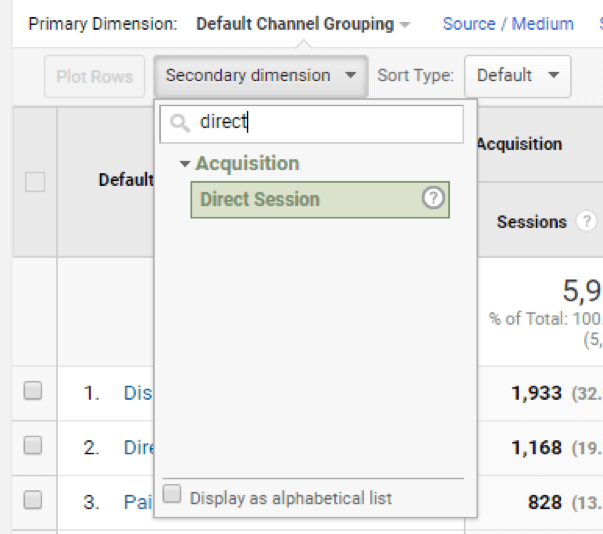Step-by-Step Overview: Leveraging Secondary Dimension in Google Analytics
Step-by-Step Overview: Leveraging Secondary Dimension in Google Analytics
Blog Article
Unlock Deeper Insights With Second Measurement in Google Analytics
With the large stretch of information available in Google Analytics, the use of secondary dimensions can significantly enhance your logical abilities. By purposefully including secondary dimensions into your evaluation, you can uncover valuable insights that may or else remain obscure - Secondary Dimension in Google Analytics.
Comprehending Main Vs. Second Measurements
When analyzing data in Google Analytics, it is vital to identify in between second and primary measurements to obtain deeper insights into user behavior. Primary dimensions are the major categories by which you can watch your information, such as source/medium, device, or touchdown page. These dimensions offer the fundamental structure for arranging and comprehending your data. On the other hand, secondary dimensions permit you to more explore your main dimension data. By adding a second measurement, you can layer on extra information to your key measurement, making it possible for a more granular analysis. If your main dimension is the source/medium via which individuals arrived on your website, adding a secondary measurement like geographical place can disclose where those individuals are situated geographically. This included layer of details can assist you recognize patterns, patterns, or abnormalities that may not have actually appeared when checking out the primary measurement alone. Leveraging both secondary and main measurements in Google Analytics is vital for thorough data analysis and educated decision-making.
Utilizing Additional Measurements Properly
By integrating secondary dimensions along with main measurements, analysts and marketing experts can dive deeper right into the specifics of individual interactions on their sites. Secondary measurements allow customers to section and filter main measurement data additionally, providing an extra in-depth sight of user behaviors, communications, and demographics.
In addition, additional dimensions enable individuals to contrast and contrast various data factors within a solitary report, helping with a more extensive evaluation of user habits patterns. By leveraging additional measurements successfully, businesses can uncover concealed understandings, maximize their marketing approaches, and enhance the overall customer experience on their sites.
Exploring Common Second Dimension Combinations
To additionally evaluate individual habits and trends in Google Analytics, it is important to discover common combinations of second measurements. Some typical second measurement mixes that offer useful insights include evaluating website traffic resources with user areas to understand where web site site visitors are coming from geographically and just how they found the site. Checking out user behavior metrics with additional dimensions such as rate of interests or demographics can help in targeting particular audience sections extra successfully.
Using Secondary Dimension in Custom-made Information
Utilizing secondary dimensions in customized reports enables a much more detailed evaluation of data in Google Analytics, improving the deepness of insights gotten. When producing custom records in Google Analytics, incorporating second dimensions can offer a much more in-depth view of how various dimensions communicate with each other. This attribute makes it possible for customers to dive much deeper right into their data and discover beneficial relationships that might not be immediately evident.
By using second dimensions in custom-made reports, users can obtain a much better understanding of their internet site or application web traffic. For instance, incorporating the main dimension of "source/medium" with the secondary measurement of "touchdown page" can disclose which touchdown pages are performing ideal for web traffic coming from details resources. This insight can help marketing professionals optimize their campaigns and improve total conversion rates.

Enhancing Information Visualization With Secondary Dimension
When discovering data in Google Analytics customized records, including secondary measurements not just provides a more in-depth analysis but likewise improves the aesthetic representation of insights with data visualization. By adding a secondary measurement to your records, you can enrich the way information exists, making it simpler to determine patterns, patterns, and correlations within your internet site's performance metrics.
Secondary measurements can help you segment your information further, enabling a deeper understanding of customer behavior and interactions on your site. When attempting to separate particular variables that may influence your internet site's efficiency., this improved level of granularity can be specifically valuable.

Conclusion
In conclusion, leveraging additional dimensions in Google Analytics permits a more thorough analysis of information, causing much deeper insights and even more enlightened decision-making. Secondary Dimension in Google Analytics. By adding added layers of information to main data sets, online marketers and experts can uncover covert fads, patterns, and connections that offer a granular sight of customer behavior and interactions. This improved degree of insight allows optimization of projects and customized techniques for details target market segments, eventually boosting efficiency and conversion prices
On the other hand, secondary dimensions permit you to more explore your primary dimension data. By including an additional measurement, you can layer on extra details to your main dimension, making it possible for an extra granular evaluation. If your find this primary dimension is the source/medium via which users showed up on your site, adding an additional measurement like geographical area can expose where those individuals are situated geographically. By integrating additional dimensions together with main dimensions, analysts and marketing experts can delve deeper right into the specifics of customer communications on their internet sites. Second measurements enable individuals to section and filter main dimension information even more, supplying a much more in-depth sight of individual demographics, actions, and interactions.
Report this page